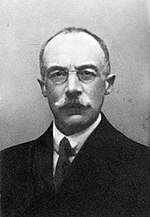Max van Berchem
| Max van Berchem | |
|---|---|
 | |
| Born |
16 March 1863 Geneva |
| Died |
7 March 1921 (aged 57) Vaumarcus |
Max van Berchem (16 March 1863, Geneva – 7 March 1921, Vaumarcus) was a Swiss epigraphist and historian. Best known as a pioneer of Arabic epigraphy, he created "Corpus Inscriptionum Arabicarum", an impressive collection of Arabic inscriptions.
History
He studied at the Universities of Geneva, Leipzig, Strasbourg and Berlin, receiving his degree in 1886 with the dissertation La propriété territorial et l'impôt sous les premiers califes.[1]
After graduation, he embarked on scientific expeditions to Egypt (several trips from 1887 to 1890), Jerusalem and Palestine (1888, 1893 and 1914), and Syria (1884, 1895). On these journeys he studied and collected a vast amount of Arabic inscriptions ("Matériaux pour un Corpus Inscriptionum Arabicarum"). Being aware of the enormity of this project, he divided the work amongst others, mostly French and German scholars, with Berchem, for the most part, limiting his personal investigations to the cities of Cairo, Jerusalem and Damascus. In his work, he used photography as a means to record Arabic inscriptions. Between 1895 and 1914, he dedicated most of his time and energy towards the publication of the large amount of textual material that he had accumulated.[2]
Since 1973 the "Max van Berchem Foundation" has financed archaeological excavations, research projects and studies in Islamic art and architecture throughout the Middle East and north Africa.[3]
Associated works
- Matériaux pour un Corpus inscriptionum Arabicarum (1894-1925).
- Berchem, van, Max (1894). Matériaux pour un Corpus inscriptionum Arabicarum (in French and Arabic). Paris: Ernest Leroux.
- Berchem, van, Max (1909). MIFAO 25 Matériaux pour un Corpus Inscriptionum Arabicarum Part 2 Syrie du Nord (in French and Arabic). Cairo: Impr. de l'Institut français d'archéologie orientale.
- Berchem, van, Max (1914). MIFAO 37 Voyage en Syrie t.1 (in French and Arabic). Cairo: Impr. de l'Institut français d'archéologie orientale.
- Berchem, van, Max (1915). MIFAO 38 Voyage en Syrie T.2 Additions et corrections. Index général (in French and Arabic). Cairo: Impr. de l'Institut français d'archéologie orientale.
- Berchem, van, Max (1917). MIFAO 29 Materiaux Pour Un Corpus Inscriptionum Arabicarum III Asie Mineure (in French and Arabic). Siwas, Diwrigi. Cairo: Impr. de l'Institut français d'archéologie orientale.
- Berchem, van, Max (1920). MIFAO 45.1 Matériaux pour un Corpus Inscriptionum Arabicarum Part 2 Syrie du Sud T.3 Jérusalem Index général. Cairo: Impr. de l'Institut français d'archéologie orientale.
- Berchem, van, Max (1920). MIFAO 45.2 Matériaux pour un Corpus Inscriptionum Arabicarum Part 2 Syrie du Sud T.3 Fasc. 2 Jérusalem Index général. Cairo: Impr. de l'Institut français d'archéologie orientale.
- Berchem, van, Max (1922). Materiaux Pour Un Corpus Inscriptionum Arabicarum (in French and Arabic). 2 part, 1 volume. Cairo: Impr. de l'Institut français d'archéologie orientale.
- Berchem, van, Max (1922). Materiaux Pour Un Corpus Inscriptionum Arabicarum (in French and Arabic). 2 part, 1 volume, premier fasicule. Cairo: Impr. de l'Institut français d'archéologie orientale.
- Berchem, van, Max (1922). MIFAO 43 Matériaux pour un Corpus Inscriptionum Arabicarum Part 2 Syrie du Sud T.1 Jérusalem «Ville» (in French and Arabic). Cairo: Impr. de l'Institut français d'archéologie orientale.
- Berchem, van, Max (1927). MIFAO 44 Matériaux pour un Corpus Inscriptionum Arabicarum Part 2 Syrie du Sud T.2 Jérusalem Haram. Cairo: Impr. de l'Institut français d'archéologie orientale.
- Inscriptions arabes de Syrie, 1897 – Arab inscriptions of Syria.
- Epigraphie des Assassins de Syrie, 1897 – Epigraphy of the Assassins of Syria.
- Materialien zur älteren geschichte Armeniens und Mesopotamiens, (with Carl Ferdinand Friedrich Lehmann-Haupt), 1906 – Materials pertaining to the ancient history of the Armenians and Mesopotamians.
- Amida: Matériaux pour l'épigraphie et l'histoire musulmanes du Diyar-bekr, 1910 – Amida, material pertaining to the epigraphy and Islamic history of Diyarbakır.
- Voyage en Syrie, 1913 – Voyage to Syria.
- "Opera minora".
- La Correspondance entre Max Van Berchem et Louis Massignon : 1907-1919 – Correspondence with Louis Massignon, 1907–1919.
- Max van Berchem, 1863-1921 : hommages rendus à sa mémoire, by Alice van Berchem (1923).
- La Jérusalem musulmane dans l'œuvre de Max van Berchem by Marguerite Gautier-van Berchem, (1978).
- "Muslim Jerusalem in the work of Max van Berchem", by Marguerite Gautier-van Berchem (1982).[4]
- "Corpus Inscriptionum Arabicarum Palaestinae addendum squeezes in the Max van Berchem collection (Palestine, Trans-Jordan, Northern Syria) : squeezes 1-84", (2007).[5]
References
- ↑ Historisches Lexikon der Schweiz (biography)
- ↑ Fondation Max van Berchem (biography)
- ↑ Fondation Max van Berchem
- ↑ OCLC Classify publications
- ↑ Open Library Corpus Inscriptionum Arabicarum Palaestinae